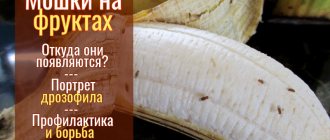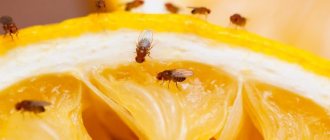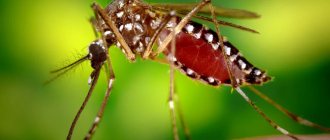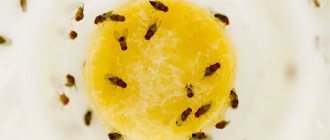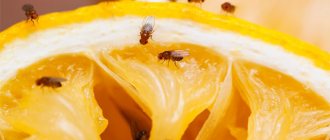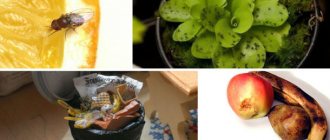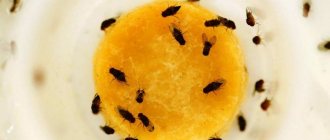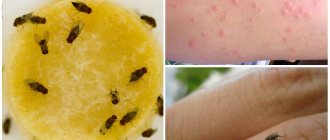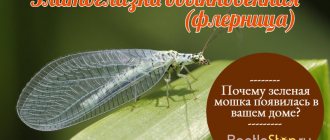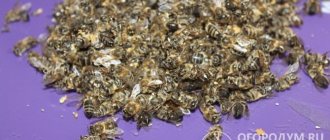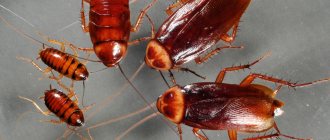When will the midge end? This question arises for many people who have been attacked by these small blood-sucking insects. Midges can live both in the natural environment and in a private house or city apartment.
They cause significant discomfort to humans and are carriers of many dangerous diseases. That is why the question of when the midges will disappear is of particular relevance.
Midges are small blood-sucking insects that look like miniature, hunched-over mosquitoes. In total, there are more than 4,000 species of midges; at least 200 species live in Russia. The blood-sucking insect has a body measuring 1-5 mm, black or dark gray. It consists of a rounded abdomen, head and thorax.
Female midges are larger in size, have a pointed abdomen and the presence of wide antennae. The question of when midges will disappear is of interest to people who have been attacked by small blood-sucking insects.
Single midge bites do not pose a serious danger to humans. But at the time of the bite, the midge injects a specific toxic substance into the human blood, which can cause pain, redness of the skin, and swelling at the site of injury.
Insects have transparent wings and differ from mosquitoes by shortened legs and a short proboscis
Numerous midge bites can cause a severe allergic reaction, accompanied by itching, burning, dangerous complications including angioedema and anaphylactic shock.
Features of midges
It is customary to call a midge a humpbacked mosquito, but unlike it, a mosquito has a proboscis and shorter legs. Midges are a type of fruit fly. They can appear at home at any time of the year. The body length of the insect varies from 1 to 6 mm, the color is black or speckled gray. The body consists of 3 parts:
- abdomen;
- breasts;
- heads.
You can distinguish a female from a male by size and body structure. Female individuals are larger, have a pointed abdomen, and a wide forehead. There are short, thick antennae on the head. The abdomen of males is rounded. The wings of insects of both sexes are transparent and tuberous. When the midge is at rest, the wings fold, one on top of the other. Types of kitchen midges:
- Drosophila. Most midges feed on spoiled, rotten fruits and vegetables. This is the type of midge that is most often found in the kitchen. They also love sweet, fermented alcoholic drinks, which is why they are also called wine midges. They are not indifferent to wet fabrics and trash cans. The size of Drosophila is 1-3 mm, the color can be any shade from yellow to brown.
- Sewer. They are carriers of various bacteria and enter the house through sewer systems. The color of the insects is black, the wings are shaggy.
Note! A few insect bites do not pose a threat to humans, but if there are many of them it can become dangerous. When attacked, the midge injects an anesthetic liquid that is poisonous. A small wound remains. Itching and swelling appear.
Habitat
Midges live in similar conditions to mosquitoes, since they are close relatives. For the development of larvae, the insect requires an aquatic environment, a reservoir or a pond. They firmly grasp the stems of aquatic plants or rocky surfaces, descend under the water, and lay eggs there. A small incubator is formed. Where else do insects live:
- In southern countries you can find huge concentrations of midges in vineyards and orchards.
- The ideal habitat for fruit flies is in a human home. It's always warm there, there's a lot of food.
- They often settle in fruit warehouses, wine and juice factories.
There are many midges throughout the planet, only in Antarctica and the Sahara they are absent.
Interesting! Midges occupy a significant place in the natural world, since most birds and mammals feed on them.
Development process
One female can lay up to 400 eggs in her life, from which larvae emerge. This happens after 24 hours if the conditions for their reproduction and growth are suitable. Drosophila goes through 4 developmental phases: egg, larva, pupa, imago.
- One laid clutch contains 50-100 eggs. The shape of each egg is oval, the size does not exceed 0.5 mm. It takes 5-7 days to ripen.
- The hatched larvae look like worms. Their body length is 3.5 mm, color is white. The larva moves with the help of a special hook located in the thoracic region and fixing the location of the suction cup. Until the moment of pupation, they live in a semi-liquid mass of rotten fruits, actively eating their juice and microorganisms.
- On the 5th day, the pupation period begins, lasting 5 days. The shape of the cocoons can be different; their surface is covered with hairs.
- 24 hours after birth, the young midge reaches sexual maturity and is ready to reproduce. On the 2nd day she is able to lay eggs.
It will be difficult to destroy small insects if the nest is not found and removed in time.
Note! Depending on the environmental conditions, the period of development of the larva into a young individual is 10-20 days.
Lifespan
The lifespan of fruit flies depends on their living conditions and diet. Males prefer to feed on flower nectar, and females prefer to feed on the blood of birds, animals, and humans. Drosophila that consume plant sap live no more than 7 days. Blood-sucking midges can live from 1 to 3 months. Life expectancy of domestic animals:
- If the room is well heated in winter, then indoor midges can live for about 3 months. At the same time, they reproduce well.
- The lifespan is reduced to 20 days if the air temperature does not rise above 18 °C.
- Drosophila live for about 10 days at temperatures above 25 °C.
The peak activity of midges occurs in the autumn-spring period, as they do not tolerate heat and extreme cold. If they live in nature, then the parasites survive the cold months in the egg stage. Wintering in regions with a hot climate takes place in the larval stage; in the summer, the adult moves to a reservoir.
Note! In order for the midges to die within 24 hours, you need to lower the air temperature in the house. If the weather is cool outside, it is enough to ventilate the room at night.
Ways to get into the apartment
To quickly get rid of fruit flies, you need to understand how they got into the apartment. This can happen in several ways:
- through street clothes;
- with soil for indoor plants;
- from neighbors, through ventilation and sewer openings;
- with dirty fruits and vegetables;
- from a trash can that hasn’t been taken out for a long time.
Interesting! The most favorite place in the kitchen for fruit flies is the filter under the sink. It gradually becomes clogged with food debris, which rots and becomes a source of insect spread.
Life cycle
Each clutch of a butterfly midge contains several dozen brownish or cream-colored eggs. The larvae, provided there is sufficient heat and humidity, appear within 2 days.
In 1-2 weeks they turn into an adult. The entire life cycle is no more than 3 weeks.
Sciarid midges lay eggs (up to 250 eggs in a clutch) in the soil of a flower pot or damp, rotten wood. The larvae - legless transparent worms 2-5 mm long with a translucent intestine - appear after a week.
The larva to pupa stage lasts about 2 weeks, then the pupal phase begins. It lasts up to 8 days, after which an adult sciarid appears, which will live from 3 to 7 days.
A female fruit fly lays an average of 400 eggs in her lifetime. After a day, midge larvae will emerge from the eggs. Ontogenesis (development from egg to adult) of Drosophila at 18˚C is 20 days, at 25˚C – 10 days.
The larvae grow for 5 days, moulting for the first time in a day, the second in two days. For the next 5 days, the Drosophila is in the pupal stage.
After emerging from the cocoon, the adult is ready to mate within 12 hours. An adult midge does not like heat: it lives 10 days at a temperature of 25˚C, 20 days at 18˚.
The life cycle of a whitefly consists of the following stages:
- laying eggs (mainly on the upper leaves of domestic plants). The average number in one clutch is 80 pieces. Midge eggs are pale green, 0.2 mm in size, after 1-2 days they turn brown;
- from 7 to 13 days, the eggs mature and black or dark brown larvae appear (transparent, 0.25 mm long). They molt three times, increasing to 0.9 mm. They feed on plant sap and are mobile. The larval stage lasts from 7 to 15 days;
- The larva loses mobility and the formation of a protective shell (prepupa) begins. The period lasts 5-7 days;
- The next stage of midge development (pupation) is the longest. Depending on environmental conditions, it can take from a week to 4 months. The pupal stage lasts from a week to a month. The warmer the surrounding air, the faster the process occurs.
The lifespan of the whitefly midge depends on the type of plant. The female lives up to 24 days, males - up to 16 days.
Types of midges
In the apartment you can find the following types of midges: fruit flies, sciarids, butterflies, whiteflies. They are safe for humans, but can spoil plants and infect food with larvae.
Drosophila are small red midges that fly slowly, changing direction chaotically (moving in a straight line with sharp turns). Rotten, overripe vegetables and fruits are their habitat and reproduction.
They appear mainly in the kitchen near the sink, bucket, and vegetable drawers. They can reproduce on the rotting pulp of cacti.
Sciarids (detritus, fungus gnats) are translucent midges with a black body. They live in the top layer of soil of flower pots in rotten plant debris.
These midges breed especially actively on waterlogged, acidified soil under Saintpaulias (violets), orchids, and chrysanthemums. There are two ways to get into the apartment: with purchased soil or from the street (through open windows).
They multiply especially actively during cold weather, when the evaporation of moisture from the soil slows down.
Sewer midges (butterflies) are small butterflies resembling moths that live in rooms with high humidity. They often appear in houses with faulty sewerage, old pipelines, and damp basements.
They enter the apartments through ventilation ducts and pipes. Eggs are laid on rotting plant debris. They fly slowly and over short distances.
They are usually seated on ceilings and walls. Some information sources contain information that butterflies carry dangerous diseases, but there is no official confirmation of this.
Whitefly (aleiroda) is a type of midge that parasitizes mainly greenhouse crops.
In apartments it appears with soil purchased for flowers or seedlings, with house plants or seedlings. Such midges rarely come in from the street through windows.
Types and characteristics of flies
There are two types of midges: fruit flies and sciarids. The former reproduce in fruits (fruits, berries, vegetables), the latter - in the soil. Sciarides also appear in apartments when there are indoor plants. The insect feels comfortable: it can feed in the kitchen, and constant watering of home flowers provides the necessary moisture.
Before getting rid of midges in the house, their type is determined, because... methods of struggle are different. Fruit insects are eliminated by throwing out rotten fruits and taking out garbage. You can't do this with sciarids. You will have to work with the soil of the plants to influence them.
Drosophila fly
Danger to humans
Apartment midges do not pose a direct danger to humans. They don't bite, so they don't spread diseases or other infections. But since there are many ways to get rid of flies (chemicals and folk remedies), there is some danger:
- Damage to products. If a midge gets to fresh food, it destroys its integrity. Subsequently, it may become completely unusable.
- Destruction of stocks. Many people store onions, potatoes and other vegetables in bags for the winter. The appearance of harmful insects can damage some of the stocks, as well as destroy them completely.
- Annoyance. Besides the fact that insects constantly fly into your eyes, nose and mouth, they stain white tablecloths, curtains and towels.
- Damage to house plants.
The situation is complicated by the fact that the midge nest is difficult to find. And it reproduces very quickly (20 larvae at a time, the ability to reproduce begins 8 hours after birth).
Are fruit flies dangerous?
The flies themselves are not dangerous to humans: they do not bite, since their jaws are simply unable to bite through even the thinnest skin.
Flies are annoying with their flickering, they constantly come to hand.
However, this is not the most unpleasant consequence that an insect invasion leads to; the danger of fruit flies lies elsewhere. Pests feed on organic matter, including waste from landfills and animal feces, and their sweat. They can contain dangerous bacteria, which flies carry on their legs or proboscis and then leave on food.
Thus, a pathogenic bacterium can enter the human body, which, if the immune system is weakened, will lead to intestinal infections. In addition, eating food with fruit fly eggs on the surface causes diarrhea and nausea, accompanied by a rise in temperature.
Interesting Facts
Reproduction is impossible without saturating the females with human blood. Therefore, mosquitoes are spread over almost all areas of land where humans live. They stay close to settlements so that they can drink the blood of people at any time.
Each species has its own preferences in temperature and lighting conditions. Some people like shady ponds, others like well-lit ones. Biologists have calculated that the larvae are able to develop when the water temperature is 10–35 °C, but between 25 °C and 30 °C is considered most comfortable.
Mosquitoes rarely lay eggs in large bodies of water where many fish live, because they readily feed on eggs.
The larva will die if the water is contaminated with oil products: they form a film on the surface through which the worms cannot breathe. But some species show enviable adaptation, having adapted to use oxygen dissolved in water for breathing.
The process of how mosquitoes appear has been sufficiently studied by science. These insects are characterized by high fertility and feeding on human blood. Both of these traits are directly dependent on each other.
What do midges and their larvae eat?
Midges are small insects that resemble humpback mosquitoes in appearance. Their size does not exceed six millimeters, and some species can be even smaller. Before talking about what midges eat, it is necessary to understand the features of their structure and habitat.
Characteristic features of the insect and its nutrition
Despite the fact that flies belong to the family of small mosquitoes, they have some distinctive features. The structure of the midge has its own individual characteristics. They are distinguished by strong short legs and a short proboscis, the structure of which allows them to easily bite through the skin. Midge bites are painful and fraught with unpleasant consequences.
The female midge is an excellent diver. In order to lay eggs, it dives into the water, clinging to the stems of algae or stones. Some individuals prefer to leave their clutches in the coastal strip or simply drop their eggs while flying over a flowing stream.
The hatched midge larva is immediately attached to the nutrient substrate with the rear end of its body using special hooks. Since females lay eggs in groups and always in running water, huge colonies consisting of larvae form in this place of the stream. Their number can reach up to 200 pieces per square centimeter. Periodically contracting “fans” located near the mouth indicate that midge larvae begin to feed immediately from the moment of their appearance.
The special structure of hairs and bristles, which serve to trap food, allows organic residues to be extracted from water. This is the main nutrition of the developing individual. The larva can feed fully only when there is a strong current in the reservoir. In stagnant waters they die immediately. Adult flies emerge from the pupa after two weeks. They rise to the surface of the reservoir and fly out of the water.
Interesting! The adult midge eats only on hot sunny days. The rest of the day or in bad weather it is not active. Mainly females feed on blood, while males prefer nectar from flowers.
What do midges like to eat?
Fruit insects living in kitchen conditions do not overeat their food. It is not difficult to see what midges eat by observing their behavior. They give particular preference to the following “food sets”:
- Spoiled vegetables and fruits. Fruit and onion midges can eat them all the time. They also need them for reproduction, since larvae develop from laid eggs in the rot.
- Home canning. Open cans are an excellent bait for omnivorous insects
- Pet food.
- Flower midges, such as sciarids, feed on underground parts of plants.
- Residues of animal products containing blood.
Knowing who midges are, what the peculiarities of their life and nutrition are, you can get involved in an active fight against insects.
Reasons for the appearance of midges in an apartment in winter
Midges are tiny flying insects that reproduce quickly. Most often, homes are infested by fruit flies. They, like flies, are considered carriers of dangerous infections.
Let's look at where midges appear in an apartment in winter:
- garbage not taken out on time. Decaying vegetables and fruits are the best breeding ground for fruit flies.
- Wet places in the bathroom and kitchen. Residues of food stuck in sewer pipes.
- Flower pots. Moist soil is ideal for fruit flies to breed. They can feed on organic plant remains.
- Missing vegetables in pantries and basements.
- Ventilation holes, gaps, cracks.
- Stagnant and missing water in flower vases or aquariums.
- Pet cages not cleaned on time.
Small midges are afraid of the cold. Despite this, fruit fly attacks can occur even in winter. The room temperature of heated rooms is optimal for them. A midge that accidentally flies in becomes the founder of a swarm.
What do fruit midges eat?
Such insects feed on absolutely all types of fruits, or rather, on their rotten remains and other naturally processed products. Young individuals prefer to eat fresh fruit juice. It helps them grow faster and produce healthy larvae.
A common question is how long midges live in the summer. During the warm season, the average lifespan of a fruit fly is one month. In nature, due to the lack of fruits in the cold season, the fly can feed on the sap of trees, grass, flowers and leaves.
The insect lives in countries with warm tropical, subtropical or temperate climates. Some species of fruit flies can drink the blood of people or animals to support their life cycle.
How long do midges that feed on blood live? Approximately 20 days. The most common place for them to live is in vineyard plantations, because no one will fight the influx of such insects over vast areas. Plus, midges really love grapes.
Fighting and preventing midges on the street
Chemical preparations for midges
It is difficult to fight harmful midges living in nature, but it is possible. To do this, you must follow a number of rules:
- do not walk near the river in the hot daytime (especially where there is a lot of vegetation);
- use repellents;
- midges do not like windy weather, so use this factor to your advantage;
- Wear light-colored clothing that covers your arms and legs.
Methods for getting rid of fruit gnats
Midges appear in our apartments along with southern fruits; they can live in trash cans or bags of fruit. Midges can appear even if nothing has gone bad at home and there is no fruit. The thing is that eggs can be laid in advance.
Absolutely fresh store-bought products may already contain fruit fly eggs. They are not dangerous to the human body, but it is still quite unpleasant to realize the presence of fly larvae on food.
20 days is the answer to the question of how long midges live on the street. It’s quite easy for them to find something to eat in garbage dumps. However, strong winds and other weather factors significantly shorten their life outdoors.
In order to destroy the maximum number of midges and their larvae, follow these tips:
- Find and destroy their main habitat in your home.
- Place traps in other places where they may accumulate.
- Regularly take preventive measures that will not allow fruit flies to appear indoors in large quantities.
Habitat
The midge most often lives in places with high humidity. Pests usually accumulate in last year's foliage and near water bodies. In mid-summer, the insect appears in the growing area of fruit trees and bushes. Parasites are attracted by the smell of spoiled food, so midges can often be seen near trash cans and in places where rotten vegetables accumulate.
The pest also often occurs in residential areas. Midges in a room or kitchen can appear as a result of purchasing berries and fruits that have insect eggs on them. Adults can appear at any time, including in winter, if the room has all the optimal conditions for their life.
Depending on the insect species, the habitat may vary.
The following types of midges are distinguished:
- Drosophila - appears in rooms where there is missing food or garbage has accumulated;
- clothes - the pest appears in dirty linen or wet things. Most often, this parasite appears near laundry bins or in the closet;
- floral - pests accumulate in the soil. Occurs due to improper watering;
- water - manifests itself in outdoor conditions near bodies of water, indoors in places where moisture accumulates.
Externally, insects have similar features and can attack humans. When a midge bites, it releases poison into the skin, resulting in swelling and redness.
Insect eggs can survive exposure to low temperatures. They are deposited on the fruits, and when optimal conditions arise, a new generation of midges appears in a short time.
How long do midges live?
Midges appear most often in old housing stock, but such insects can also be found in new apartments. Their lifespan is short, but the size of the colony does not decrease due to high fertility.
The fight against midges is often delayed due to the fact that adult individuals mature quickly and manage to lay a large number of eggs in a short time. They do not bite people, they annoy people solely with their presence.
Homemade
How long midges live in apartments depends on several factors:
Reasons for appearing in the house
Drosophila can reproduce and generally be localized in the following places in the apartment:
- in the kitchen, pantry and wherever vegetables and fruits are found, especially those starting to spoil;
- in the bathroom, where there may be wet rags lying around, there is a leaking sewer or a clogged sink;
- in rooms around indoor plants;
- near animal feeders (if you rarely clean them).
And there are many more places that flies can choose, as long as it is dirty and wet.
However, owners of clean apartments, who always keep order, complain about fruit flies no less. Where then do these little annoyances come from and why do they appear clean? There are also several options here:
- from the sewer;
- from fruits purchased in a store or market, on the peel of which the fly has already laid eggs;
- from the trash can;
- from purchased spoiled fruits (if the rotten place was not immediately noticed);
- from contaminated wastewater, etc.
There are plenty of ways for flies to enter a house, but there are no fewer ways to prevent them from entering an apartment.
How does life expectancy change at different times of the year?
Insects appear after the air warms up; midges can remain in the egg or pupal stage for a long time. In the summer, when the air temperature reaches 25 degrees or higher, insects reduce their activity and may disappear completely.
At the end of summer, midges can appear in large numbers. Especially during the ripening period of grapes and other fruits.
In autumn, after the air temperature drops below 18 degrees, insects reduce their activity.
Bite process
Midge bite
When bitten, a substance that acts as a painkiller gets into the wound with the saliva of the midge. Therefore, the very moment of biting and absorbing blood remains invisible to humans. The pain occurs only after some time, when it has already flown away.
Redness and swelling occurs at the site of the bite. The wound is very itchy. These phenomena are caused by the fact that midge saliva is poisonous.
If there are a large number of bites, swelling may occur not only on the surface of the wound, but also on the internal organs. In some cases, hemorrhage occurs and symptoms of severe poisoning appear. This situation requires immediate medical attention and emergency assistance.
On the territory of Russia, the largest number of midges is represented in the taiga zone. How many species and who pose a threat to life? The following species pose the greatest danger to humans:
Consequences of a midge bite
- tundra midge;
- Kholodkovsky midge;
- decorated midge.
The air temperature (comfortable for midge life) at which an attack on a person occurs ranges from +6 to +23˚С.
How many diseases can this small insect carry? Particularly dangerous are midges that carry diseases such as:
- plague;
- leprosy;
- tularemia;
- glanders;
- anthrax.
At what time does the midge disappear?
The street appearance of midges disappears when the air temperature drops. Most often, this period occurs in early autumn. The insects lay eggs and die. The next season, the place where the eggs were laid will act as a nursery from which new offspring will emerge.
The lifespan of midges in apartment conditions is different. Indoor insects can appear even in winter. The pest can leave only after adopting special protection techniques.
Prevention
In order to maintain cleanliness and hygiene in the house, regular prevention should be carried out against long-lived fruit flies. How long do midges live in the kitchen? 35-45 days. Such a long period of residence is explained by a sufficient amount of food and a warm, well-lit room.
Rinse your trash can even if you use bags. Don't put vegetables in cabinets. Take inventory of your refrigerator and pantries regularly.
By following all the simple instructions described in this article, you will forget about such a pest as the small fruit midge.
Ways to get rid
The appearance of midges in the house is a problem that requires close attention. At first, their appearance may go unnoticed, but given their rapid reproduction, they will soon begin to cause serious harm. Some varieties of midges require an individual approach to destruction, but most can be exterminated using standard methods.
Classic methods
Classic methods are usually the most reliable. They can help get rid of insects in a short time, but they require certain precautions.
Most often used in the fight against midges:
- Aerosols against insects. The compositions “Dichlorvos”, “Kombat”, Raid still help cope well with pests. Use them strictly according to the instructions, not forgetting about protective equipment.
- Fumigator. Most often, the device is used against mosquitoes, but it is also effective in the fight against other insects. You just need to find plates or a special liquid against flies.
- Sticky traps. Unlike sticky tape, which is often used against flies, these traps are much easier to use.
- Light trap zappers. Devices based on electrical stimulation of insects are not very effective as the main weapon against midges, but can help as an auxiliary tool.
It is important to remember that the use of chemicals must be accompanied by precautionary measures.
Thus, surfaces must be treated strictly with gloves and, preferably, a respirator or mask to avoid exposure to toxic substances. Do not use sprays or other products near food or children's toys. There should be no children or pets in the apartment during treatment.
All about the life of a mosquito and its longevity
It is unlikely that you will meet a person who has no experience of meeting a mosquito, but the thought of meeting one is unlikely to make anyone happy, so we often wonder how long this annoying random acquaintance lives and stays awake?
Sometimes it even seems that he is a close relative of the notorious Koshchei the Immortal, because no matter how much effort you make in exterminating the tormentor, it seems that he comes to life again and again and multiplies with incredible power. To understand this issue, let's consider some features of the common mosquito, the most common in our country.
planet out of 3 thousand species of mosquitoes existing in nature. Despite its inconspicuous appearance (a small elongated body of a gray-yellow color with several pairs of long legs and transparent wings), the mosquito owes its universal fame to the long proboscis located on its head, with the help of which it feeds.
It should be noted that mosquitoes of both sexes usually feed on plant juices and nectar. But as soon as the time comes to breed, the female adds animal or human blood to her diet, while the male adheres to his usual diet. A pregnant female chooses her meal based on the heat and carbon dioxide released by the victim’s body.
Having overtaken her, the mosquito pierces the skin with its proboscis and injects a special substance into the victim’s wound that prevents the blood from clotting. The site of the bite can be identified by a swollen reddish spot that may itch for several days. Mosquitoes usually live in places where there is enough moisture - in forests, river valleys, and lakes.
But it just so happens that these are the places that attract us as a place to relax, to merge with our mother nature. And here, contrary to our wishes, a very close acquaintance with mosquitoes is inevitable.
And for those who do not need nature or simply cannot afford to go there, there is news: scientists recently discovered a new species of common mosquito - the urban one. Such mosquitoes live mainly in flooded basements of houses.
How long does a mosquito live after biting a person?
It is a common belief that mosquitoes die immediately after biting their victim, however, this statement is erroneous (unless you take into account the fact of death at our hands, slamming the torturer at the crime scene). A sexually mature female can feed on blood about 8 times in a few hours, while remaining in a joyful mood.
It turns out that the presence of a constant source of food, on the contrary, prolongs the life of the female and gives her the opportunity to reproduce full-fledged offspring, ready to “delight” us with their bites for at least 3 months.
How long can mosquitoes live in an apartment?
When winged “friends” find themselves in an apartment, many do not attach much importance to this, being confident that mosquitoes will not last longer than two days there. However, this is not at all true, because most likely females came to visit you for a cup of blood.
At a temperature of 25 degrees, the female will live happily next to you for about 43 days. If the temperature drops, the life expectancy of the blood-sucking guest increases and can reach up to 120 days.
Moreover, if the female considers you a hospitable host (that is, you do not allow yourself the impudence to attempt on her life), your apartment may well serve as a maternity hospital for the young offspring of the uninvited guest.
She will lay her eggs in a dark, damp place - a bathroom, toilet, hallway or closet, and you'll soon have a new one waiting for you. Therefore, you should not neglect insect control products if your apartment is easily accessible to mosquitoes.
Use of folk remedies
Professional chemicals are considered the best way to get rid of small midges in a house or apartment. However, not everyone is ready to breathe in unknown substances, because their safety for people and pets remains in question for many. In this case, the owners prefer to use folk recipes, tested by people and time, which are guaranteed not to have any negative impact on the health of all residents of the house.
Help from essential oils
This is one option that will make the house unattractive to any type of insects, because they cannot tolerate many strong odors. For example, midges will definitely not like the aromas of the following essential oils:
- cedar, pine;
- vanilla, cloves, geranium;
- ylang-ylang, lavender, incense;
- lemon, tangerine, mint, tea tree;
- patchouli, wormwood, tansy, fir, juniper.
Oils are used in different ways. Some owners drip etherol onto lampshades or cold lamps, onto heating appliances, or spray solutions. Other owners prefer aroma lamps, while others place branches of fragrant plants or pieces of zest in their rooms.
It is believed that any method will bring results. However, this “essential” option can be used in one case: if there are no allergy sufferers in the house, small children or pets who are extremely sensitive to any strong aromas.
Making homemade traps
The most original method of dealing with tiny insects is using a vacuum cleaner. After such fishing, it is recommended to quickly clean the container or bag; it is better to do this outside. However, such an activity can hardly be called exciting, because if there are few midges, then the hunt will most likely end in nothing.
Traps, on the contrary, are a completely working option. Such containers, in which any bait is placed, become a trap from which insects cannot escape. There are several ways to create traps, as well as available materials (and baits).
Disposable glasses
This is the simplest option. To make a trap, not only a disposable cup is suitable, but also other small dishes: for example, leftover yogurt. Bait is placed at the bottom. This could be fermented juice, pieces of rotten fruit, jelly or compotes, beer, homemade kvass or wine. However, real apple cider vinegar is considered the most favorite treat for midges. You can buy it, or prepare it yourself.
The glass with the treat is covered with cling film, in which a small hole is made with a needle. Through a tiny hole, insects will be able to get inside, but will no longer be able to get out. When enough “victims” have collected in the trap, it is placed in a bag (or wrapped in film) and taken out of the house.
Glass jar and napkin
A similar method is used to catch cockroaches, so this option can also be tried on their smaller “colleagues”. One of the types of bait is placed or poured into the bottom of a glass jar (500 ml). Roll a funnel from a napkin or sheet of paper, the height of which is approximately 2/3 of the depth of the container. The hole is made small. The funnel is carefully inserted into the jar, then fixed motionless with tape.
The principle of operation of this trap is similar to a glass covered with film. A hungry and “thinner” insect flies to the smell and gets to the free treat. The feast begins: the midges eat to their fill (they get fat before our eyes), so they can no longer get out.
Dishes with “killer” bait
In this case, a dose of poison is added to the attractive food. There are two recipes that are considered quite effective in the fight against small midges.
Midges and protection against it
To reduce midge populations in their natural habitat, streams and swamps are drained, forests are carefully cleared, and banks along water bodies are cleared.
To protect livestock from midge bites, livestock complexes or summer grazing pens are located away from wetlands and low-lying areas. During periods of excessively high activity of midge flights, it is advisable to keep animals indoors by installing mosquito nets on windows and doors. The walls of the room can be treated with insecticidal preparations such as Bytex, Actellik, Metathion, Difos. Ear tags for animals impregnated with Alletethrin, Resmethrin and similar drugs have a good effect. To protect themselves from midge bites, people have to look for more and more new solutions. It is quite possible to protect yourself from the attacks of these annoying, annoying, and sometimes dangerous blood-sucking insects, if you take into account some nuances:
- do not rest near bodies of water, the banks of which are overgrown with lush vegetation;
- during the period of midge summer activation, try to wear clothes of not too light colors, covering the body as much as possible;
- avoid long stays in swampy lowlands and damp, shady forests;
- Staying near livestock farms usually risks being attacked by a swarm of midges - exclude such places from your list of stops for a picnic or a country walk.
In order to protect yourself from attacking midges, you should use protective measures such as repellents or fumigants.
- Repellents are midge-repellent substances in the form of sprays, ointments and various strong-smelling lotions, manufactured industrially or homemade (based on folk recipes). They are applied to exposed areas of the body, blocking the olfactory receptors of midges.
- Fumigants have a completely different principle of action: they contain toxic substances that cause the death of midges.
Folk remedies for midges
- Infuse ordinary vegetable oil (preferably refined) for 2-3 weeks in a dark and cool place on clove buds, wormwood leaves, parsley, tobacco, eucalyptus, fir branches, vanilla pods or anise seeds. Then the oil should be filtered and, if necessary, lubricated with it on areas of the body;
- You can make an ointment based on baby cream or regular Vaseline, including crushed lavender leaves, bird cherry inflorescences, basil, rosemary, crushed garlic or finely grated lemon zest;
- Place walnut shells (about 250 g) in 500 ml of alcohol diluted to 30-35 degrees or in half a liter of vodka, add 10-15 drops of camphor oil or 30-40 drops of peppermint oil. After a couple of days, this tincture can be used by lubricating the skin with a swab dipped in liquid.
- you can simply smear the exposed areas of the body with vanilla, which is sold in bags. The smell of vanilla repels midges.
Factory-made midge repellents
- Mosquitall ointment – contains vanilla extract and diethyltoluamide, has a repellent effect on midges, the effect lasts 8-9 hours;
- Aerosol Help - the product can be applied to both skin and clothing. Valid for 6-8 hours. Not recommended for use by children under 12 years of age, as well as pregnant and lactating women;
- Aerosol Gardex is a product based on ethyl alcohol and diethyltuolamide. The period of protective action is 4.5-6 hours.
Before using these products, be sure to test for allergic reactions: apply a minimal amount of the drug to your wrist and observe whether the skin in this area turns red or begins to itch.
Fumigators against midges
Fumigators against midges are divided into pyrotechnic and electric. In the first, a spiral smolders and smokes, impregnated with substances toxic to midges. Fumigators of the second type work by heating an element on which a plate impregnated with a substance poisonous to midges is placed. Another option for a fumigator is an element that connects to an outlet, to which a bottle of toxic liquid is attached. Among the most current fumigators are devices from the brands Raid, Mosquitall, Fumitox.
How to deal with insects in the kitchen
Midges in a room where food is prepared daily are an undesirable event that requires urgent action. Flying insects worsen the mood of all people living in the house, fly into plates of food, and leave traces in all rooms. You can fight small midges using home and professional methods.
Thorough inspection
Identifying the factors that influenced the spread of midges is the most important task, since only the destruction of the source of active reproduction and development of insects will allow us to lose their company for a long time. Before getting rid of midges in the kitchen, you should carefully consider the food. It is important to make sure that there are no midges in the soil in which the flowers are planted, as well as in washbasins and drains not only in the kitchen, but also in the bathroom. It is a thorough inspection that will help identify the habitats of flies.
Homemade traps
The use of traps is a way to effectively combat flies. Types of devices that can be made at home:
- PET glass. Place a slice of rotten fruit and a couple of tablespoons of juice on the bottom of the container. The top of the glass is covered with polyethylene, holes are made in it through which midges can penetrate. They shouldn't be too big. At night, the glass should be placed in the kitchen, and in the morning a midge will be found in it, which climbed into the glass for the aroma of the bait, from where it was not able to get out.
- From glass containers. The bait is placed in the container in the same way. Then you need to twist the paper funnel and position it so that its widened side matches the circumference of the jar, and the narrow side does not reach the bottom. The flies will fly in, but they won’t be able to crawl out.
- From adhesive tape. Midges stick to the sticky layer and cannot detach.
- From a detergent-based solution. Juice or nectar is poured into any container, which acts as a bait for insects. You should also add a little dishwashing gel there. Midges that fly into the container will drown in the resulting solution.
- Made from paper soaked in a special liquid. This effective method causes some inconvenience, since sheets that are soaked in a special solution are hung everywhere. Preparation: 3 tbsp. sugar, 6 tbsp. Mix ground black pepper with 500 ml of milk. Midges will be attracted to this mixture, and then they will die.
- A mixture of milk and formaldehyde. 10 tbsp. sweetened water, 2 tbsp. formaldehyde and 6 tbsp. milk are mixed in a bowl, which is then placed in the room with the midges. Insects die from contact with such a solution.
Description of mechanical methods
If you have neither the time nor the desire to make traps, you can use mechanical methods:
- Through ventilation. Air currents will carry insects outside.
- Vacuum cleaner. Everywhere where insects sit needs to be vacuumed. They will end up in the bag and will not be able to fly back out. But the container with dust must be shaken out or thrown away, because it is also an ideal breeding ground for midges.
- Camphor. You should heat the frying pan and pour the crushed preparation onto it. The fumes will spread throughout the house and the midges will die. This product is absolutely safe for adults and children, as well as pets.
- Aromatic oils and incense. Most of all, insects cannot stand the smell of cloves, patchouli, and verbena.
- Installation of mosquito nets on windows.
Kitchen
The most important rule is to never leave a trash bin overnight. The next steps will be:
Garbage bin in the kitchen with leftover vegetables
- monitor the freshness of products (prevent the formation of rot);
- It is recommended to use adhesive tape (both outside and inside cabinets);
- washcloths and washcloths should be twisted and dried after use;
- prevent the formation of fatty deposits and clogging of the drain pipe of the sink and hob;
- no leakage or contamination of taps;
- make homemade traps in the form of a cup with rotting fruit or unfinished juice (the area where a large number of midges get in, it must be tied tightly and thrown away).
Chemicals
The fruit fly is the most common insect in our climate zone. Its size is a maximum of three and a half millimeters in length and 0.5 millimeters in width. Creatures live around fruits and vegetables that have spoiled or are simply in uncovered containers. The midge's body is brown in color and has small black wings on its back. A female insect lays 200 to 500 eggs throughout her life. How long do midges live? On average fifteen to twenty-five days. This indicator depends on climatic conditions and nutrition. In apartment conditions, the larvae turn into young individuals after 27 hours. On average, they take four to six days to mature.
The small larvae of these midges also feed on rotting fruits. They are attracted by the smell of wine and grapes. Each of us constantly sees these insects in the summer; they are everywhere: on the streets, in our apartments, shops. That is why the problem of getting rid of them becomes urgent. This is quite difficult to do, but in the article we will still look at several ways.
Their attack on our products continues as long as mosquitoes and midges live. Throughout their short lives, they feed on rot and other waste so that they can lay eggs and give birth to offspring.
Onion fly can be combated in a more radical way - using chemicals. They are more harmful than traditional ones, but more effective. There are a large number of preparations that can be used to spray onions.
Lifespan of a mosquito
Mosquitoes prefer to live near bodies of water with standing water, in shady forests, lowlands, and swampy areas. This choice of habitat is explained by the fact that the development of insect larvae occurs in water. One of the most common species is the common mosquito. It is he who bothers a person to a greater extent. The green bell mosquito is also often found, but people are not of interest to it.
The main period of insect life is summer. The lifespan of a mosquito depends on a number of conditions:
- Environmental temperature has a great influence on the development and life of insects. The most optimal range is from +10 to +15°C. The female lives in such conditions for about 3-4 months. At a temperature of about +20 degrees, its life expectancy in the absence of other harmful factors will be 2 months. If the temperature exceeds 25° above zero, the female will live no more than 40 days. In similar conditions, the male lives 2 times less than the female.
- Where mosquitoes live, humidity plays an important role in creating favorable conditions for their development. That’s why insects so often choose damp basements, cool utility rooms, and pantries as their home. This is where you need to look for their clusters, trying to find out where the mosquitoes come from.
- The availability of food is an important aspect for maintaining insect life. The mosquito menu depends on gender. Males feed on plant foods - nectar and plant juice. Females need a constant source of blood. It can be a person, an animal, an amphibian, or even a fish.
- Natural enemies that feed on mosquitoes have a direct impact on the insect's life cycle. They are birds, other insects, and insectivorous animals. Humans also contribute to shortening the lives of bloodsuckers.
Under ideal conditions, a female mosquito can live for a whole year, surviving the winter in a state of torpor. It is not difficult to calculate how long an ordinary mosquito lives in real conditions. Typically, the life of a female lasts no more than 40 days, and males die after 20 days.
Mosquito
Traps
- The most ordinary glass jar. Take a larger jar. Then put in it several pieces of slightly rotten or fresh fruit (it is worth noting that midges will fly to rotten fruits and vegetables faster). You can pour a little compote and put some sweet candies. Place the jar in a visible place or near the insects' habitat. Roll a funnel out of plain white paper. Insert it into the jar. This should be done with the tip down. This way, it will be easy for fruit flies to get into the jar, but they will never get back out. Wait until as many insects as possible are trapped and throw the contents of the jar outside. Never throw everything in the trash. There they will only continue to reproduce. How long do midges live in a trash can? Small colonies can live there for up to four months.
- Take the most common plastic disposable cup. Put some sweet bait there. Even a used fruit aromatic tea bag will do. Cover the cup tightly with cling film. And make small holes in this film so that the midges can crawl through. Wait until a large number of midges (15-30 pieces) bite the bait.
- Plastic bag. Take one garbage bag. Open it up as much as possible and place a few slices of fruit in the middle. Wait for the fruit flies to fly and close the bag quickly. Take it to an outdoor trash container.
Destruction of midge habitats
Most often, fruit flies live in the trash can, rotten produce (apples, strawberries, grapes, strawberries, blackberries, watermelon, melon and other common summer fruits and vegetables), bags of vegetables and fruits, cabinets and flowerpots.
How long do fruit flies live? One fly lives in a warm room for a month, but their numbers can grow exponentially. Find the place where they are most concentrated. Sometimes insects can live in a container that contains some kind of chemical, such as a paint can.
Check the refrigerator. Midges can live in jam jars and jugs of compote. You should try to tightly seal all containers in which foods made from fruits or vegetables are stored.
Usually the larvae turn into full-fledged fruit midges in the early morning, so a lot of them accumulate in the first half of the day. Towards evening, the activity of annoying insects gradually fades away.
